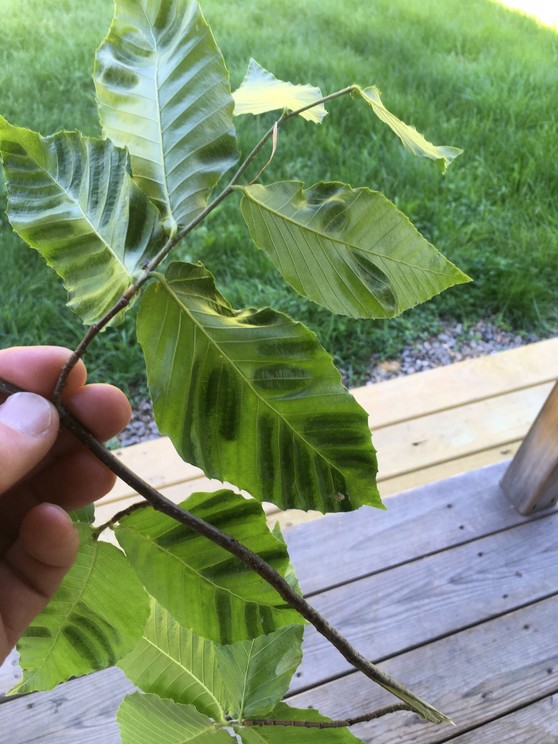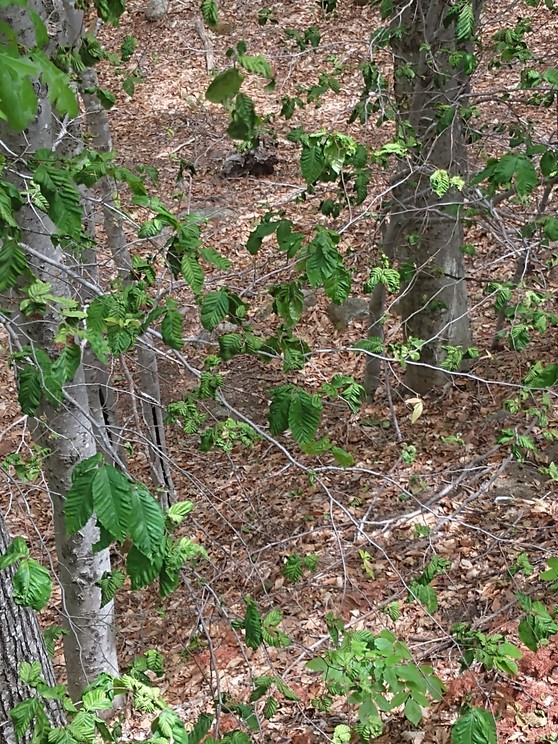An Unwelcome Arrival: Beech Leaf Disease Detected in Maine
A disease that has been leading to decline and mortality of beech trees from Ohio to Southern New England has arrived in Maine’s forest. Beech leaf disease was confirmed in leaf samples from a forest in Lincolnville, ME (Waldo County) by Dr. Robert Marra of Connecticut Agricultural Experiment Station. The diseased trees were brought to the attention of the Maine Forest Service’ Pathologist by the landowners, who pay attention for changes in their frequent walks through their forest. Symptoms of the disease have since been seen in towns from Belfast to Rockport and inland to Searsmont and Hope. It appears to be widespread in the Midcoast, and is likely found elsewhere in Maine.
Beech leaf disease was first reported in Ohio in 2012, and for many years it was known only in adjacent states and provinces. 2019 marked the first detections of the disease in eastern New York, and in 2020 a concerted survey and outreach effort uncovered the disease in southern New England and other areas.
Symptoms of beech leaf disease include:
- Dark bands form between the veins of leaves;
- Leaves become curled, deformed, and shriveled;
- Trees develop a thin canopy.

There is a lot that is still unclear about beech leaf disease. We do know:
- Beech leaf disease can kill both American and European beech;
- Beech leaf disease symptoms are associated with the presence of a non-native foliar nematode (microscopic roundworm);
- Disease symptoms tend to begin in smaller beech trees, however larger trees are also vulnerable to attack and decline;
- Across the region this spring, there are reports of a ‘sudden appearance’ of symptoms in stands where no readily detectable symptoms existed in 2020. Our observation of widespread symptoms in the region of the initial report is similar to reports from southern New England states this spring.

Mysteries include:
- Details of how the disease develops and impacts forest ecosystems and how that development is different in stands already ravaged by beech bark disease;
- How the disease is spread;
- Whether other organisms (bacteria or fungi for instance) are needed for disease development or if the nematode can cause disease without other agents;
- If there are other plants that could be impacted by the nematode or organisms associated with them;
- If there are effective ways to manage the disease (several methods are being tested for use in ornamental trees);
- If there are any beech trees with tolerance of or resistance to the disease.
Maine Forest Service will continue to monitor developments as more is learned about this disease. However, at this time, there are no proven methods for management.
American beech in Maine is already greatly impacted by a different invasive forest pest. The beech scale, introduced near the turn of the last century, makes beech vulnerable to attack from native fungi and the two together result in beech bark disease. This disease has made beech undesirable in the eyes of many who own and tend forests because thickets of diseased beech develop after some types of harvests. Even in this compromised state, beech plays an important role in Maine’s forests. Beech is well known for producing the most nutritious of any of our hard mast species (other common hard mast trees are oaks) and is an important food source for many wildlife species. It is also particularly important as a species that provides cavities for wildlife that require them for nesting or denning. Even compromised by disease, beech is still used in furniture, flooring among other products.
The Maine Forest Service is asking the public’s help in identifying additional areas impacted by beech leaf disease. Photos of suspected affected leaves can be submitted in our online form; reports can also be made to foresthealth@maine.gov or by calling (207) 287-2431. If possible, photos should include a clear shot of the underside of an affected leaf or leaves, however, please report concerns even if those photos cannot be provided.
|